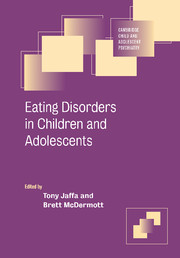Book contents
- Frontmatter
- Contents
- List of Contributors
- Part I Introduction
- Part II Scientific underpinnings
- Part III Abnormal states
- Part IV Evidence-based care
- 16 Assessment and treatment of acute medical complications during the refeeding process
- 17 Assessment and treatment of chronic medical complications
- 18 Individual psychotherapy
- 19 Evidence-based family psychotherapy interventions
- 20 Models of service delivery
- 21 Psychopharmacology and eating disorders
- Part V Public health perspectives
- Index
- References
16 - Assessment and treatment of acute medical complications during the refeeding process
from Part IV - Evidence-based care
Published online by Cambridge University Press: 02 December 2009
- Frontmatter
- Contents
- List of Contributors
- Part I Introduction
- Part II Scientific underpinnings
- Part III Abnormal states
- Part IV Evidence-based care
- 16 Assessment and treatment of acute medical complications during the refeeding process
- 17 Assessment and treatment of chronic medical complications
- 18 Individual psychotherapy
- 19 Evidence-based family psychotherapy interventions
- 20 Models of service delivery
- 21 Psychopharmacology and eating disorders
- Part V Public health perspectives
- Index
- References
Summary
Introduction
This chapter explains the refeeding syndrome, how to prevent it and how to treat it should it occur. Next, the causes, differential diagnosis and treatment of serious acute medical syndromes that occur during refeeding are explained. Finally, the indications for paediatric consultation are listed.
The refeeding syndrome: acute nutritional management
The refeeding syndrome is a combination of signs and symptoms that can result from feeding a malnourished patient (Golden & Meyer, 2004). It may occur along a spectrum that ranges from none, to the sudden onset of congestive heart failure. Typically, signs and symptoms will include oedema and aching bones and muscles.
Deficiency states in anorexia nervosa
It is important to consider what deficiencies are likely to exist at the beginning of the refeeding process in children and adolescents. This is particularly true of children and adolescents because growth and development increase nutritional requirements. As most patients with anorexia nervosa have had unhealthy eating habits for many months or years (Golden et al., 2003), their stores of nutrients are likely to be severely depleted. However, it is difficult to know which nutrients will be deficient because the pattern of food intake may have been significantly disrupted by purging. Furthermore, patients may take vitamin or mineral supplements in an attempt to compensate for nutritional deficiencies. A further complication is that baseline nutrient stores in the normal human body vary greatly from nutrient to nutrient.
Keywords
- Type
- Chapter
- Information
- Eating Disorders in Children and Adolescents , pp. 195 - 211Publisher: Cambridge University PressPrint publication year: 2006

